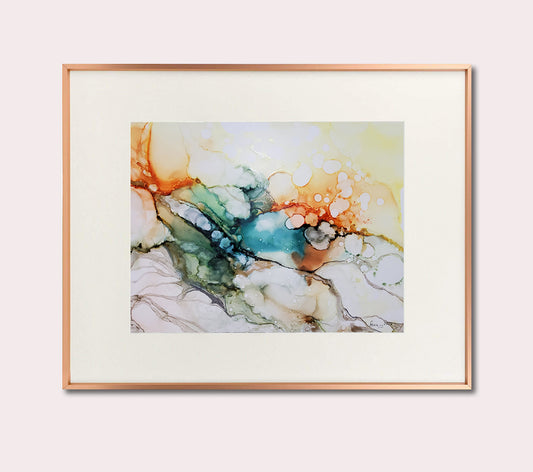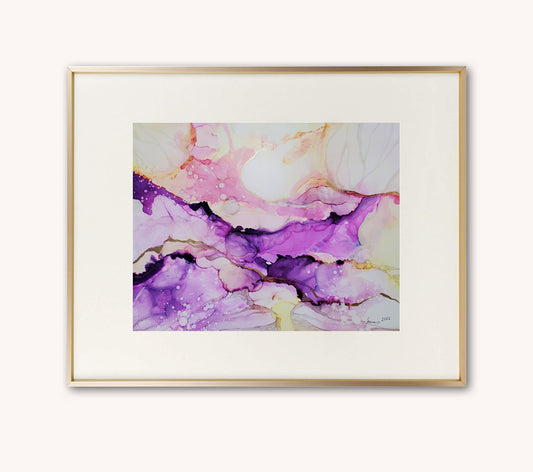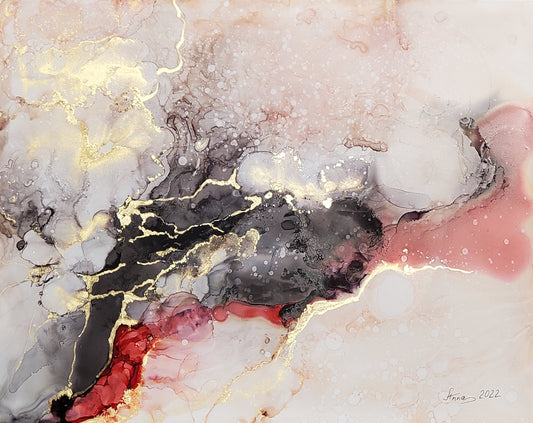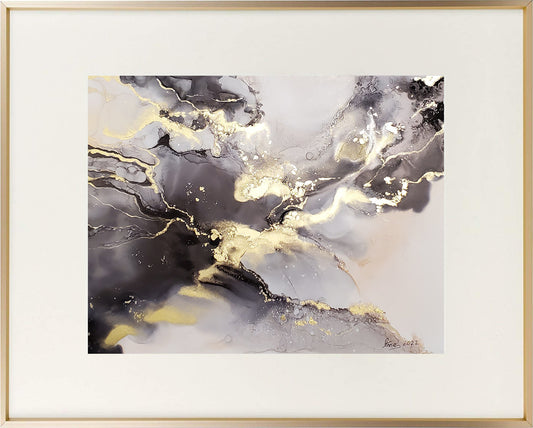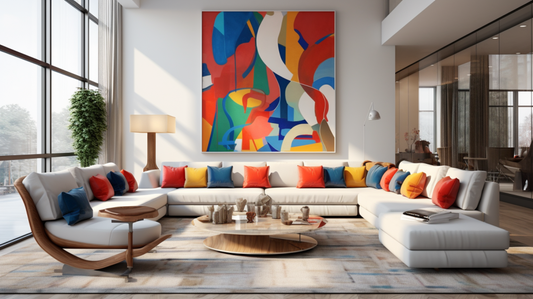Abstract art is a realm of boundless creativity and limitless expression, where artists use colors, shapes, and forms to convey their emotions and ideas. It's a genre that has captivated art enthusiasts for decades, and it continues to thrive in the contemporary art world. One question that often arises, both among artists and collectors, is, "What colors sell the best in abstract art?" While there's no definitive answer, this article will explore the fascinating relationship between color psychology and the marketability of abstract art. We'll delve into the preferences of collectors and highlight the works of modern abstract artists to shed light on this intriguing aspect of the art world.
The Psychology of Color in Abstract Art
Color is a powerful tool in the hands of an abstract artist. It has the ability to evoke emotions, set moods, and even influence decision-making. To understand what colors sell the best in abstract art, we must first explore the psychology of color.
Red: The Color of Passion and Energy
Red is a color that often signifies passion, love, and energy. In the realm of abstract art, bold red hues can command attention and evoke intense emotions. For example, the renowned artist Mark Rothko, known for his large color field paintings, often used deep shades of red to create a sense of profound emotion in his works. His painting "No. 6 (Violet, Green and Red)" demonstrates how red can dominate a canvas, drawing the viewer's eye and creating a strong emotional response.

Blue: The Color of Serenity and Tranquility
Blue is often associated with serenity, tranquility, and introspection. In abstract art, artists like Yves Klein and his iconic "IKB" series employed various shades of blue to create a sense of calm and contemplation. Blue can be a popular choice for abstract art collectors seeking pieces that bring a sense of peacefulness to their living spaces.

Yellow: The Color of Happiness and Optimism
Yellow is a vibrant, cheerful color that exudes happiness and optimism. In abstract art, artists like Wassily Kandinsky used shades of yellow to convey joy and positivity. His painting "Yellow-Red-Blue" is a perfect example of how yellow, combined with other bold colors, can create an electrifying and dynamic composition.

Green: The Color of Growth and Renewal
Green is often associated with nature, growth, and renewal. Abstract artists like Ellsworth Kelly have employed various shades of green in their works to connect the viewer with the natural world. Kelly's piece "Spectrum I" demonstrates how green can be used to create a sense of balance and harmony in abstract art.

Black and White: The Timeless Combination
Black and white, while not technically colors, are often used in abstract art to create striking, high-contrast compositions. Artists like Franz Kline are renowned for their use of black and white in abstract expressionist works. Kline's painting "Black, White and Gray" is a prime example of how this timeless combination can captivate viewers with its stark simplicity.

Multi-Color Compositions: A Riot of Emotion
While individual colors hold significant meaning, many abstract artists opt for multi-color compositions that combine various hues to convey a range of emotions. For instance, Piet Mondrian's famous "Composition II in Red, Blue, and Yellow" is a pioneering work in the De Stijl movement that uses primary colors and non-colors (black and white) to evoke a sense of balance and harmony.

Understanding the psychology of color is a crucial step in discerning which colors might sell the best in abstract art. Artists can use this knowledge to guide their creative process, and collectors can consider the emotional impact of colors when selecting pieces for their collections.
Collector Preferences: What Sells in the Market
The preferences of art collectors play a significant role in determining what colors sell best in abstract art. While individual tastes can vary greatly, some general trends have emerged in the art market.
Neutral Colors for Versatility
Many collectors prefer abstract art with neutral colors, such as whites, grays, and earthy tones. These colors provide versatility, allowing the artwork to blend seamlessly with a variety of interior design styles. The abstract works of Agnes Martin, for example, often feature neutral palettes, emphasizing subtlety and minimalism.

Vibrant Colors for Impact
On the other end of the spectrum, vibrant and bold colors can also be highly sought after. These colors make a statement and can serve as a focal point in a room. Artists like Jackson Pollock, with his iconic "Autumn Rhythm," use bold and energetic colors to create a dynamic impact.

Monochromatic Minimalism
Minimalist abstract art has gained popularity in recent years. Many collectors appreciate the simplicity and elegance of monochromatic works, often in shades of black, white, or gray. The artist Ad Reinhardt is well-known for his black monochromatic paintings, like "Abstract Painting, 1960-65."

Personal Connection
Collectors often choose abstract art based on a personal connection to the colors used. Some may be drawn to colors that hold sentimental value or remind them of specific experiences. For example, an abstract piece with a dominant blue palette might resonate with someone who has fond memories of the sea.
Trends and Art Movements
Art market trends and movements can also influence color preferences. For instance, during the mid-20th century, the Color Field painting movement, led by artists like Mark Rothko and Helen Frankenthaler, emphasized the use of bold, saturated colors. Such movements can shape collector preferences for particular color palettes.
Examples from Modern Abstract Artists
To further illustrate the impact of color in abstract art and what sells well in the market, let's examine the works of some contemporary abstract artists:
Gerhard Richter
Gerhard Richter is a renowned German artist known for his diverse range of abstract and representational works. In his abstract pieces, Richter often uses a subdued color palette with shades of gray, white, and soft pastels. His work "Abstract Painting (726)" is a beautiful example of how neutral colors can create a sense of tranquility and contemplation, making them appealing to collectors who seek a sense of calm in their spaces.

Julie Mehretu
Julie Mehretu is an Ethiopian-American artist celebrated for her intricate and layered abstract compositions. She frequently employs a combination of bold and vibrant colors, such as blues, reds, and yellows, interwoven with complex geometric shapes. Her work "Dispersion" is a testament to the allure of multicolored, dynamic abstract art that captivates collectors looking for artworks with a strong visual impact.

Mark Bradford
Mark Bradford, an American artist, is known for his abstract paintings that incorporate collage elements and a rich interplay of colors. His work "Los Moscos" exemplifies the use of a wide range of colors, from vibrant reds and blues to earthy tones. Collectors drawn to the complexity and energy of multicolored abstract art may find Bradford's works particularly appealing.

Carmen Herrera
Carmen Herrera, a Cuban-American artist, is celebrated for her geometric abstract art. Her works often feature a limited color palette, with striking combinations of two or three colors. "Blanco y Verde" showcases her mastery of using a minimalist palette, consisting of white and green, to create a visually engaging and harmonious composition.

These examples from contemporary abstract artists highlight the diversity of color palettes and the impact they can have on the viewer. Artists continue to experiment with colors, pushing the boundaries of what abstract art can be and challenging collectors to explore their own preferences.
The Intersection of Color and Artistic Intent
While collector preferences and market trends play a significant role in determining what colors sell best in abstract art, it's important to remember that the choice of color is intimately tied to the artist's intent and the message they wish to convey.
Abstract artists often select colors with a specific purpose in mind, whether it's to express emotions, comment on societal issues, or explore the interplay of light and form. For example, the abstract artist Josef Albers, famous for his "Homage to the Square" series, dedicated his life's work to exploring the effects of color interactions and the perception of depth through simple geometric forms.

Artists like Albers remind us that color in abstract art is not just about aesthetics but is also a fundamental tool for conveying meaning and provoking thought. Collectors who appreciate the deeper layers of an artwork often consider the artist's intent and the context of their choices when evaluating the role of color.
The Role of Art Galleries and Exhibitions
Art galleries and exhibitions also play a crucial role in shaping collector preferences for color in abstract art. Gallery curators and exhibition organizers often curate shows that highlight particular color palettes, themes, or artistic movements. These exhibitions can introduce collectors to new artists and encourage them to explore different color aesthetics.
Moreover, the lighting and spatial arrangement in galleries can dramatically affect how an artwork's colors are perceived. Well-designed gallery spaces can enhance the impact of certain colors and influence collectors' choices.
Conclusion: The Colorful World of Abstract Art
The question of what colors sell the best in abstract art is a complex and multifaceted one. While there are general trends and collector preferences, the world of abstract art is vast and varied, with no one-size-fits-all answer.
Colors in abstract art have a profound impact on the emotions and perceptions of viewers. From the passionate reds of Mark Rothko to the tranquil blues of Yves Klein, each color has a unique role to play in the realm of abstract expression. Artists continue to experiment with colors, pushing the boundaries of what abstract art can be and challenging collectors to explore their own preferences.
As collectors and enthusiasts, it's essential to appreciate the intricate relationship between color and abstract art. While market trends and personal preferences certainly play a role, it's equally important to delve into the artist's intent and the rich history of color in the world of abstract art. Whether you are drawn to vibrant, multicolored compositions or minimalist monochromatic works, the beauty of abstract art lies in its diversity and capacity to provoke thought and emotion through the language of color.
Intrigued by the fascinating world of abstract art? Your artistic journey doesn't have to end here. Explore a mesmerizing collection of captivating and modern abstract artworks by visiting our Abstract Art Collection and Shop. Our gallery is a treasure trove of creativity, where you can not only see but also acquire unique pieces that resonate with your aesthetic sensibilities. Dive into a realm of imagination, emotion, and innovation as you discover the transformative power of abstract art. Don't miss the opportunity to enrich your surroundings with these thought-provoking creations. Start your exploration now and let the art on this page inspire your soul.


